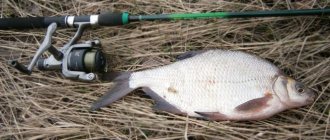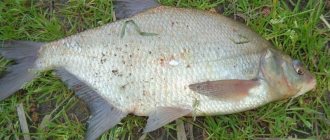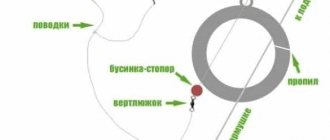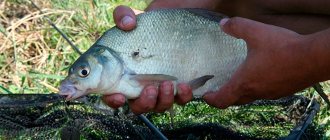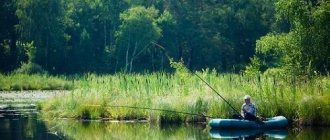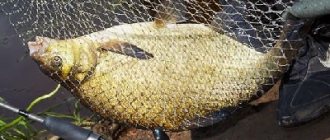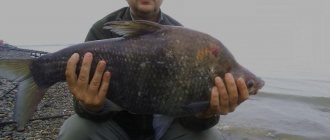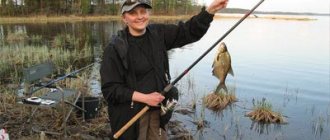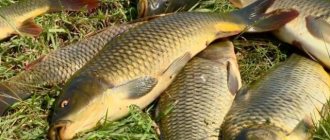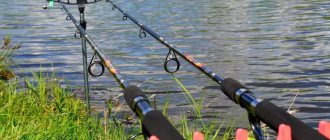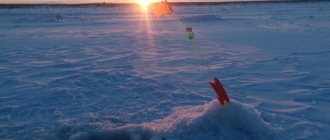10 February 2021 Victor Home page » Autumn fishing Views:
Welcome to my blog! In this article I will describe what bream fishing is like in the fall. How to choose the right place for fishing, what gear to use. You will learn that fishing in the fall has its own characteristics and requires a certain approach that is different when fishing in summer, spring and winter. When choosing gear for catching bream, there are several factors to consider. This includes the depth of the reservoir, the distance, and the behavior of the fish.
With the onset of cold weather, fish adapt to a different way of feeding and existence. And this means that anglers need to change their approach from summer fishing to autumn. This applies to rigs, groundbaits and lures. The fish stops constantly feeding; the colder it gets, the less frequent its exits to search for food become.
Choosing a place to fish in the fall
A good place for fishing with the onset of autumn is the dumps of river reaches. These places have a lot of vegetation and food availability. And if you find a spot of bream, then with the right bait you can keep it in place for a long time and still have a good catch. The presence of shells in dumps means that you may also catch a roach. Bream in the fall generally does not enter shallow areas of water, which means that there are few fishermen on the dumps of river reaches, this is another plus in favor of fishing in these places. There will be no unnecessary noise on the pond that interferes with good fishing. Especially when catching large specimens.
Due to the fact that bream constantly moves in the water and takes bait as soon as it falls into the water, feeder tackle and donks are not suitable. Also, the bream is located at a distance from the shore and it is difficult to lure it to the shore at this time, so fly rods and plug rods are not suitable. Our choice settled on match and Bolognese tackle.
Reachs on reservoirs are also different. Not all reaches are the same in terms of the number of fish and catches. Where the river widens, the edge is weakly expressed and usually runs far from the shore. The best place to choose a place for fishing can be considered places where there are thickets of water lilies or places where the river goes for fishing. Plants play the role of covering the fish from various dangers and in them it feels safer. Only for us this can be a problem in catching fish from these thickets. But here you can clean the bottom and approaches to the water before starting fishing for more convenient fishing.
Before you start fishing, examine the bottom of the reservoir for holes, canopies, and slopes. The best place for feeding is the foot of steep slopes, slopes at the exit of pits. After determining the fishing location, you can start feeding the place. The first morning outing of bream to bite occurs at about 9 o'clock and lasts two hours, then the mass outing occurs at lunchtime, from about 13 to 15 o'clock. In the evening, the bite occurs from 5 pm until dark. With the onset of darkness, the bream moves to deeper places.
Spinning bream fishing in the Ob
The vast majority of spinning fishing enthusiasts use spinning rods to catch pike, asp, pike perch, perch, and catfish. Closer to mid-summer, chub, ide, and dace are caught using micro spoons. However, in a river like the Ob, in early July it is possible to catch bream using a spinning rod.
.
Which surprises many anglers who are not familiar with the characteristics of bream in this river. Spinning fishing for bream in the Ob
lasts no more than 2 weeks and often even less. However, you need to know very precisely when exactly this fishing, which is not quite typical for a spinning fisherman, begins. In addition, you need to know the places where large bream like to be.
So, on the Ob River in the vicinity of Novosibirsk, they are searched for in an area a little more than 1 km long, between the fairway and the left bank. Working depths in these places can be 1-4 m. However, the concentration of bream in this zone and at this time is affected by fluctuations in the water level.
Various ledges and rocky ridges are usually very attractive to bream. Therefore, catching bream with a spinning rod
in such places greatly increases the angler’s chances of success. The bream can stand so tightly that its bites can follow with a minimum period of time. However, in such situations, if fishing occurs from the shore, many incidents occur. Here the influence of sandbanks and strong currents is felt.
The most active bream biting time lasts from dawn until lunchtime. After noon, bream practically stops biting. Fishing for bream using a spinning rod
Unpromising on calm water. The bream is simply afraid of the spoon and therefore does not bite at all. However, there are exceptions.
Ob fishermen have many versions of the reasons for the bite and timing of the bite of bream on spinning baits. One of the most plausible versions is that at this time the juveniles of various fish slide down the rapids. At the same time, seagulls are circling over the river, which is the first sign that small fish and, after them, bream are accumulating close to the fairway.
The time of migration of the fry changes annually and depends directly on the duration of the spawning period. And this period is determined by how spring went, whether it was cold or warm, late or early. If the spring was warm and early, then bream and perch were actively biting, if it was late and cold, then there was no competition for ide.
The ide is native to the Ob River and has lived in it for a long time, while the bream was settled in the Ob only 30 years ago. Therefore, strong competition has arisen between these fish, since they have a common food supply. Probably, for ide and bream in a river that is deep at the beginning of June, the most accessible food is fry.
When an ide preys on a fry, this is determined by water stains and breakers. You can often observe how, in pursuit of a fry, an ide jumps to the surface of the water, and then, without unnecessary noise, plunges into the water.
As for the bream, during the hunt it captures the fry in its mouth and then makes random rotational movements with it. During this period, many anglers fish using a weight float on top. On the Ob it is called “bakulka”. As a rule, ide is caught with such equipment, and bream is mainly caught with equipment with a regular sinker. Therefore, successful fishing for bream and ide on the Ob
, largely depends on knowledge of these features.
After 10-14 days, after the start of the fry’s “run,” the bream stops being caught with a spoon. He again switches to traditional food and catches of bream on a spinning rod become rare, and gatherings become frequent. But ide can be successfully caught with a spoon until almost the end of August.
However, in July and August it is quite possible to catch bream using ultralight baits, primarily micro spoons.
Many winter fishing enthusiasts have repeatedly noted that often when fishing for pike perch using the vertical lure method, the lure can be grabbed by bream. Therefore, catching bream with a vertical lure
, is quite possible in winter.
As a rule, local fans of spinning bream fishing use powerful fiberglass rods or homemade duralumin rods for these purposes. They equip their tackle with reels of old Nevskaya models, etc. The base is made up of fishing line with a cross-section of 0.5 mm, and the leash is made from fishing line 0.35-0.40 mm, in addition to the leash, a “throwout” is mounted to the base. This is a piece of fishing line up to 2.5 m long and with a cross-section of 0.7 mm. It is on this segment that all the power of the jerk falls during long casts, since the mass of the load can reach 80 g or more. The reel must have a “throw” segment on the drum of several turns, which makes it possible to cast the tackle over a distance of a hundred meters, sometimes more.
If fishing for bream with a spinning rod in the Ob
, occurs from a boat, and there is no need for long casts, then light fiberglass rods equipped with spinning reels are used. The main line has a diameter of 0.25-0.28 mm, and a load weighing 35-50 g. In this case, ejection is not required.
If you catch bream in the Ob from the shore using a rod equipped with an inertial reel, then depending on the strength of the current and the weight of the load, the leash can be from 1.2 to 4 m in length.
At the same time, the greater the mass of the load, the greater the length of the leash, and the shorter the leash should be, the greater the force of the current. For gear used for fishing from a boat, the maximum leash length should not be more than 1.5 m.
The leash is mounted to the base with a loop, which should be located between 2 knots. This method of fastening allows the leash not to twist on the base. And in this case, in order to get rid of the overlap, if it does occur, they make a sharp jerk and the leash releases the main line.
Usually fishing for bream in the Ob using a spinning rod
occurs on a rotator with a yellow petal about 3 cm long and a tee hook No. 10. It is camouflaged with a bunch of red threads and a cambric located on the fore-end. If the bite goes into a low-active phase, then they begin to use smaller baits.
As for ide, this fish is caught with spoons that have a narrow blade made of copper. A tee hook, but without threads; a red cambric is put on the fore-end.
The spinner has a fairly rigid structure, while the tee is connected without a carabiner to its axis by a cambric. Thus, it is possible to prevent the spoon from intersecting with the leader during casting.
The petal can be bent using a block of wood that has a small indentation made with a round file. A metal rod or tube with a diameter of about 15 mm is used as a punch. Go around the ear of the petal with pliers. Spoons are made in various sizes and colors.
In the set, the fisherman should have a spoon with a copper or brass blade with a hook without thread and a red cambric for catching ide.
Spinner with a copper petal double hook with red threads and white cambric. A spoon with a white stainless steel petal, with a hook without threads and a white cambric. This lure is well suited for fishing on lakes in late autumn.
A spinner with a yellow brass petal, and the reverse side painted red, a hook with red threads and a white cambric on the fore-end. This spoon is universal.
Smaller spoons should be used in water with normal transparency, and larger ones should be used in muddy water or during the fast season and in places where there is a strong current.
Happy fishing!
Tackle for catching bream in autumn
The angler chooses what gear to fish with. For example, in case of strong wind or bad weather, a match rod no more than 5 meters long is best. If the weather is good, then it is quite possible to use a Bolognese rod up to 7 meters long. It should also be taken into account that match tackle is faster than Bolognese tackle.
For autumn fishing, you can use long leashes. They are good because when casting they fall to the bottom for a long time, and when using light baits they still play as they fall. Since the fish may not stand in one place, all this will attract it and provoke it to bite. And the bite usually happens when the bait has not yet reached the bottom. And if there was no bite when the bait fell, then the fish will not feel resistance when biting from the bottom, you need to put small hooks on such leashes, number 16 will be enough. Place the fishing line on the leashes no more than 0.12 mm.
If you use a thick fishing line, then you can not stand on ceremony with the bream, but pull it directly to the shore, and for this you don’t really need a long rod. The diameter of the fishing line will be 0.18 mm. It is better to take a large reel, with a classification of 2500-3000, so that 50-70 cm can be wound in one turn. We take sliding floats, preferably with the least buoyancy, with thick and not very long antennas.
The weight can be made as follows: the float is sliding, below the float stopper we place a weight weighing 0.5 g, even lower 30 cm, we place an olive sinker secured from below with a stopper. Below the olive, by 50 cm, we place a pellet weighing 0.5 g. Next, on a 30 cm fishing line, we tie a leash with a hook, the best way is loop to loop. And if there are snags or a fish that is too big bites, then you will only lose the leash itself.
The nuances of catching bream in September on a donka
I would like to ask a question about September fishing for bream on a donk. Where to look for fish in the fall, and are the equipment, groundbait and bait different in any way? I read somewhere that activity decreases towards the end of summer.
Autumn fishing for bream and bream is just as interesting as summer fishing. Biting activity depends on many factors: weather, pressure, characteristics of the reservoir, etc. Unlike the warm water season, the fall bream bite may begin closer to 10 a.m., rather than at dawn. At the beginning of autumn, flocks of white bream do not leave their usual habitats, but with a significant drop in water temperature they slide into deep channel holes. The equipment is, first of all, distinguished by its delicacy. The thickness of the leash should not exceed 0.16 mm, while hooks are used from thin wire; they are most successful at cutting fish. In reservoirs with a current, the bream bite is a little more active, since the circulation of water saturates the space with oxygen, and the rivers become covered with ice more slowly.
The behavior of the fish forces you to adapt to it. Feeding is carried out pointwise, in places where bream are definitely present. It will not be possible to lure him with an aromatic mixture to another point, since in the fall he behaves warily and leaves the fishing zone at the slightest danger. Feed is used in small quantities so as not to frighten off the fish. When working with a feeder, it is necessary to replace large feeders with smaller models. Donk fishing also does not require a huge feeding spot on the bottom. The optimal bait is considered to be a worm and maggot. The plant option has its place, but in most cases it is less effective. It is better to leave the use of additional attractants for the next summer season. The basis of the bait is pea or millet groats. Chopped worms, food bloodworms or ground zebra mussels must be added to it. It is also necessary to darken the mixture with clay or sifted soil.
To learn more:
Fishing for pike with a circle in autumn
You should start fishing in the upper reaches of the holes where the fish are accustomed to go out to feed. If there are no bites, it is worth experimenting with the fishing location, throwing donks to different parts of the reservoir. In shallow water, autumn bream is extremely rare, so you need to look for deep-sea edges and depth changes. If the hole is located under this bank, it is advisable to use a fly rod. The bait should lie motionless on the bottom, since passive fish react weakly to fishing with the wire. Elements of equipment must be delicate. The sinker is used as a sliding one, and it will serve as the main load of the float.
Feeder tackle equipment
For fishing in such places, small feeder rods, up to 4 meters, are sufficient. The current there is small and with such rods it is quite possible to examine the bottom, cast heavy feeders, and with them it is easy to pull fish through steep slopes and slopes when biting.
The reel must be powerful with a good clutch. A fishing line with a diameter of 0.2-0.3 mm is suitable. Braid or monofilament, decide for yourself. But as a rule, when fishing coastal dumps, you need to use a shock leader. The choice of what equipment you can use here is yours. Universal equipment for feeder fishing is suitable - an asymmetrical loop and a Gardner loop. The equipment can be prepared in advance at home or immediately on the shore.
But since you don’t know the strength of the current and the wind in advance, it is better to prepare several loops from fishing lines of different thicknesses. So that we could then experiment on the spot and look for which fish would like better today. The length of the leash usually depends on the activity of the fish, and ranges from 30 to 70 cm, which is also determined on the shore.
Match tackle equipment
The fishing line for such gear is made taking into account the high activity of the fish. A fishing line of 0.18 mm is suitable, make a leash from the same fishing line, or you can do without a leash at all. This will allow you to pull out trophies up to 4 kg, but the main fish will be approximately 1.5 kg. The hooks need to be small, hooks No. 16 will be enough, since the main bait will be maggots or bloodworms, you can also make sandwiches from maggots and bloodworms. When biting, it is better to use forced fishing. In this case, you need to point the rod towards the float and pull out the fish only with a reel. And near the shore, catch fish in a landing net. Such fishing should be used only when there is a strong bite, as it saves a lot of time.
In the absence of a current at great depths, a float with a load of up to 3 grams and a total carrying capacity of 10 grams is best suited, which results in a tackle load of about 7 grams. You can put several sinkers, or you can put one, an olive, with a small padding, weighing no more than 0.5 grams. Bream takes bait near the bottom, so the distance from the hook to the sinker needs to be larger, for example 1.5 meters. The exact length of the leash needed must be determined on the pond itself.
Bologna rigging
For Bolognese tackle, take a sliding float with a weight of up to 6 grams, an elongated shape with a thick antenna. This will allow you to fish with heavier baits. The distance from the hook to the sinker should also be 1.5 meters. Secure the lower float stopper at a distance of about 4 meters from the hook. If you use a longer rod, 7 meters or more, then you can use blind equipment. When catching large fish, gear breaks and breakdowns very often occur. Therefore, if possible, pack a couple more rods with you in advance so as not to waste precious time fishing.
Catching bream with a fly rod
When fishing over long distances, you need to take rods of the appropriate length. A fly rod 8 meters long or a pole 14 meters long will do. The fly rod should be of such rigidity that it can work with light equipment. In autumn, bream is more cautious and timid, so even during biting activity you need to use thinner and more sensitive tackle. You should not use leashes thicker than 0.14 mm. The thinner the tackle, the more often there may be bites. A softer bloodworm is suitable as bait. Floats should also be taken no more than 3 grams. with a thin antenna. This will make it easier to notice the rise of the float when biting.
The plug tackle must have three legs and be equipped with a rubber shock absorber. The choice of float here is less capricious and is suitable even with a load of 2 grams. Since the supply to the fishing spot will be delivered accurately without errors. The main thing here is to make the equipment so that it has time to reach the bottom and is not intercepted by other fish.
Attach the weights approximately 1 meter above the leash. And secure a small feeder 50 cm above the leash. When using fireflies at night, you need to adjust the load of the equipment.
Catching bream from a boat using a ring and an onboard fishing rod
On a large river in the warm autumn period, the most effective way to catch bream from a boat using rings and side rods.
In deep places with strong currents, “rings” are usually used, where the cord of a heavy feeder is connected using a movable lead ring to the main line of the donkey. The ring is also a sliding sinker for the donkey. When the ring with leads is lowered along the cord onto the lid of the feeder, the hooks with bait are always in a cloud of washed-out bait. (details about catching bream with a ring)
In smaller areas with moderate currents, it is better to use side rods, which are larger analogues of a winter fishing rod with a nod. The equipment is made in the form of a feeder with a leash tied above.
Pinwheels for perch
Pond on Chestka
Catching bream in autumn on a slow current
In autumn, when the air gets colder, fish change their diet. She also changes her feeding time; the main feeding time for bream with the onset of autumn is from morning until lunch. At this time, bream gathers in schools near the depths and moves in search of food. Therefore, the main thing at this time is to choose the right place for fishing. Also, for good fishing you will need a good supply of bait, and tackle for long casting; tackle with sliding equipment is suitable.
Before fishing, you need to find out what the bottom of the pond is. The best place is where the riverbed flows into holes where fish can be found. It is better to take a fishing rod no more than 4.5 meters. This rod is convenient for casting on any body of water. No bushes, trees, or other vegetation will interfere with you. Moreover, using a long rod does not mean longer casts. If you have a good reel and fishing line, you can make long casts with a small rod. And using a landing net with a long rod is not convenient.
Bream fishing in late autumn
In late autumn and early winter, the weather is not stable; constant changes in temperature and weather affect the success of fishing. In late autumn, the vegetation on reservoirs dies off and bream look for live food at this time. You can take full advantage of this moment. In such conditions, it is necessary to take into account the composition and quantity of feed supplied in the feeders. During this period, fish also adapt to a winter lifestyle. She loses her appetite, small fish stop feeding, and large fish feed less often. In such conditions you can catch large bream.
Bream fishing in autumn
Where to watch Bait
- Float Rod Feeder Other
Choice of bait Bait Catches by month
- In September In October In November
For many, fishing is not only one of their favorite and most interesting hobbies. For them it is practically a way of life. This activity gives them the opportunity to relax, gain strength, give themselves a lot of pleasant emotions and think about something. And all this is best done when fishing for bream in the fall. This fish is very common, it can be caught in a river, lake, or pond. Let's try to figure out what the features of such autumn fishing are and how you can catch large bream in late autumn, as well as what you need to know and what features of its behavior to take into account.
Where to look?
To begin with, it is important to understand where exactly to look for bream in the fall. At the beginning of this season it is worth trying to catch it in its typical summer habitat:
- Deep in the pools; in driftwood; parallel to the steep banks; in places where water flows back; near the reeds and reeds.
Closer to the autumn equator, if the weather is warm and mild, fish should be looked for in ditches located near barges. If anglers are fishing in an area they have not fished before, it is not easy to determine which areas may be suitable. However, if fishing is carried out on large rivers - the Volga, Oka or Don, it would be better to use an echo sounder, which will simplify the process of finding the habitats of these fish, and also study the topography of the river bed. with a weight on a fishing line made of lead. During this period, it is better to look for fish in the water, and holding them from a boat allows you to do this as efficiently as possible.
And at the end of autumn, almost before winter, herds of bream descend to the bottom to spend the winter in the ice hole. But, of course, I want to eat fish. Fishing here will be more effective if you catch bream with bottom tackle and use specific bait.
Tackle
Bream itself belongs to the category of bottom fish, and trying to catch it somewhere on the surface is, to put it mildly, not a very promising activity. So for autumn fishing, both summer and autumn, almost any type of bottom fishing gear is best suited. A feeding device would also be a good solution. With their help, you can make long casts, and the feeder, located on the bottom, at a short distance from the bait, will attract fish to the fishing spot planned by the angler.
Additionally, bream can be caught with a float rod. However, they need to fish close to shore in a deep hole or at least on a bank that has a bank on it.
Additionally, float fishing from a seaplane can also be successful when fishing for bream.
Float rod
Considering that in autumn the transparency of the water column is higher than at any other time, and the bream itself is a shy fish, installing a float rod should be as unnoticeable and as simple as possible. Using gear that is too thick and too large will most likely just spook the bream and swim away as far as possible.
For fishing rods in this category to be successful, the main line must be no more than 0.2 millimeters thick. Fishing hooks should be thin and as sharp as possible. This point should not be neglected, since the bait should remain alive as long as possible. If we are talking about a float, then it would be better to use a 2-gram one, which is equipped with a longer antenna. If we are fishing by long casting, then it is better to take a heavier float of a special shape. It is commonly called a lifting float. This model is interesting because the case has a series of steel rings. If we talk about the reel, then it must have the right power and have good friction, which will enable the angler to save his catch.
Feeder
Unlike the use of other types of equipment, a feeder provides a number of advantages when fishing for bream:
- constant power supply thanks to the feeder; tenderness, allowing you to notice even a bite, which is carried out by the fish with extreme caution; good casting distance, which will become increasingly important in the autumn.
When choosing this type of gear, you need to take into account a number of nuances.
- Use a spinning reel with the highest possible friction setting. The line used should be as little visible as possible. A too thick line of bright colors will only scare away wary fish, which themselves have excellent eyesight. And in combination with clear autumn water, bream sees very far and sees even the smallest details. Use size 7-9 long shank hooks. The fishing rod should be 400-600 centimeters long. This length makes it possible to throw well over long distances if the vegetation on the shore does not prevent the use of such a device. The feeder is selected depending on the bottom topography and current speed. With some skill and experience, you can get him to work on self-suspension.
Other
Other types of gear are also used to catch bream in the fall. Let's look at them too. The first option is ring fishing. This type of equipment, which many anglers forget about, is ideal for currents. It includes:
- 1 or 2 laces; A large feeder in which you can put 2 or even 2.5 kg of bait, which sinks to the bottom with the boat on a very strong fishing line; short deck rod; a lead ring through which the aforementioned cable passes, with a special hole through which the cable passes.
The principle of operation of such a device is very simple and lies in the fact that the bait, slightly lowered upstream, is slowly but constantly washed out of the feeder, attracting prey. The ring holds the bait in the place that will be behind the feeder. When you catch a bream, begin to drive it away by holding the line with your hands. In this case, the ring rises to the anchor line. When the fish are in the garden and there is a new bait on the hook, everything flows down to the feeder, which tightens the leads.
Choosing a fishing spot
At this time, bream comes out to feed mainly at night. You can catch bream in shallow water when it comes out to feed; you can also try to catch it in depth with longer rods, where it stays for a longer time. For fishing at this time you need to choose places with a depth of 4 to 7 meters. Coastal steep slopes with gently sloping areas are best suited, where you can make a good feeding area.
You can find them by examining the bottom with a weight, an echo sounder or a plug rod. In order not to waste time examining the bottom while fishing, you can come to the reservoir in advance and calmly examine the intended fishing spot. For example, before night fishing.
It is impossible to make a food base at the very edge of dumps and holes, because the food will not stay there and the fish will go down with it.
Atmospheric Pressure on Bream | Impact on Klev
What does it depend on? Let's try to figure it out.
Knowing in what weather the Bream “bites more actively”, and in what weather it won’t even stick its nose out of its favorite hole, you can catch it well and in large quantities.
Remember, regardless of the Season, Winter or Summer - if the Atmospheric pressure is within 740-745 mm above sea level, and the Weather was approximately the same over the next 24 hours. And if there are no changes in the forecast, then going fishing for Bream is not only possible, but also necessary.
If the forecast from the Hydrometeorological Center for the day when Fishing for Bream is planned indicates a clear change in the weather, active movement of air masses from north to south, due to which it will be windy. It is better to change your plans and stay at home, since the likelihood that you will catch a bream is very low. Postpone your fishing trip for a period with more favorable weather conditions.
As for the Wind, the following are suitable for Active bream biting: South-Western and Western winds, the only condition is that the wind should be moderately Weak, but not Gusty.
There is an opinion that in the Wind, when the waves are beating, Bream comes closer to the shore. This is explained by the fact that the waves wash all living creatures from the shore into the river, and this, as a rule, is natural food for Bream.
As for Fishing for Bream in the warm season: if it’s been incredibly hot “on the Street” for days, then it’s better to stay at home, the bream bite will be sluggish or completely absent.
Although in this weather, Bream is caught quite well at night. They say that if you light a fire on the shore at night, this will additionally attract bream to the fishing spot. Try it! We believe that this method has its place.
In hot weather, during the day - in water heated to +24°C, the fish is deflated and sluggish, which, of course, affects its Appetite.
If night fishing is not a problem for you, then it is better, of course, to give your preference to catching bream at night. All this applies only to coastal fishing.
If you are planning to catch bream from a boat at great depths, then heat plays a minor role here. With the right choice of place and the presence of bait, you can catch bream all day.
Fishing technique in autumn
100 gram feeders are suitable for feeding them. For autumn fish this is quite enough so as not to overfeed the fish. Also, such feeders scare the fish less, and they can quickly be delivered to the feeding area and pulled back out. It is enough to re-cast every 10 minutes.
After you have found the place where you will fish, you can start baiting the place. Throw several balls, either with your hand or with a slingshot, depending on the casting distance. And after 15-20 minutes you can start fishing. Bream can take the bait near the bottom, above the bottom or during the fall. I think you can first make the rig so that the bait is above the bottom; if there are no bites, then lengthen the leash so that the bait slowly falls to the bottom. It happens. that the bream immediately attacks the bait. as soon as she starts to fall to the bottom.
It is best to use bloodworms or maggots as bait in the fall. They are placed in bunches on hooks; #10 will be enough. You can also attach worms, but only large fish will bite on them and much less often. When the bite weakens, additional feeding must be done. If there are no bites, then it is best to change the place of fishing, move about 50 meters to another place. But if there is a good bite, then it is worth remembering this place and periodically feeding the fish there. And then you will never be left without a catch.
In autumn, fish do not very actively approach the feeding area, and if they do, it is only for a short time. Several hours may pass from the first feeding to the arrival of the bream. Therefore, you need to be patient and prepare for fishing in advance. From choosing a fishing spot and feeding it. If you plan to return to this place, it is better to add bait at night to keep the fish. Well, if you don’t manage to catch bream, then you can always catch other fish - silver bream, bream, roach.
Bait for autumn fishing
Bait is important in autumn fishing. Its composition is slightly different from that of summer fishing bait. The bait should not have a strong odor or flavorings. It should contain more proteins. You can add cake, hemp, garlic, and crackers to the bait. You also need to add clay from a local pond. Bloodworms and maggots are also always indispensable in any bait; they should be added to approximately one tenth of the total bait. To cut off bream and other small fish, you need to add chopped worms mixed with clay and sand from the pond to the bait.
At the beginning of autumn, bream actively moves around the reservoir in search of food, so at this time it is easy to collect it in one place with good bait. The density of the bait should be adjusted depending on the strength of the current, so that it does not erode too much along the bottom of the reservoir. A small trail along the bottom will be enough to attract bream to the feeding area.
To catch bream you need a lot of bait. Bream is a schooling fish and needs to be lured to your fishing spot. To do this, make a couple of dozen balls of bait the size of a tennis ball. For repeated feeding, the balls can be made smaller. The quality of the balls should be such that they fall apart near the bottom creating a cloud of turbidity, thereby attracting fish. Ideally, you need to add to the bait the bait you are going to fish with, either chopped worms, bloodworms, or maggots. But this is if you have such an opportunity.
In order for the balls to form a cloud of turbidity, it is advisable to add egg powder or cake, preferably steamed, to the bait. You can also add clay or sand from a pond to the bait. This will allow you to cast the balls further, and in the shallows will allow the bait to scatter along the bottom of the reservoir. It is better to bait the hook with a sandwich, a worm and maggot, a bloodworm and maggot.
In autumn, with the onset of cool weather, bream take food less readily. After the summer feeding, they are more careful and do not take all the food that comes their way. The bait should not have a strong odor, the bait particles should be small, large ones can scare away the fish. Mandatory for autumn bait should be soil from the reservoir. And the colder the weather gets, the more soil there should be in the bait. The bait should be red or dark red in color. You can also add various cereals to the bait. For example, millet, pearl barley. The presence of bait is also mandatory, these are worms and maggots.
In late autumn there is little vegetation in reservoirs and therefore you need to be more careful with bait. Choose only high-quality bait of a darker color. You also need to be more careful with flavorings and additives so that there is no strong odor that can scare away the fish. Since bloodworms are used as bait, they should also be included in the bait. Watch a video about catching bream in the fall:
Also read articles about the features of catching bream in the summer, catching bream in the spring, catching bream in the winter. How to catch bream on a reservoir, features of catching bream at night. What bait is best to catch bream and what gear is needed to catch large bream. For fishing to be successful and a good catch, you need to know where to catch bream.
To Home Page.
Groundbait mixture
Catching bream in September is not possible without good bait. Its use is mandatory. Bream is an active fish. He loves to constantly move around the pond in search of food. At the same time, he diligently avoids places that are not typical for him. The easiest way to collect bream around a hook with bait is to provide good bait. Moreover, it must be repeated at certain intervals if fishing is carried out with a float rod. With feeder fishing, this is no longer necessary.

